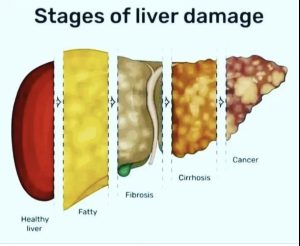 12th leading cause of mortality in the U.S. and is responsible for more than 25,000 deaths each year.
12th leading cause of mortality in the U.S. and is responsible for more than 25,000 deaths each year.
Chronic liver disease, specifically cirrhosis, is the most advanced stage liver scarring and fibrosis with an estimated 0.3% of adults affected in the US.
Fourth leading cause of death in those 45-54 years of age and the sixth leading cause of death in Hispanic Americans.
The development of cirrhosis related complications of ascites, G.I. bleeding, hepatic encephalopathy marks a transition from stable compensated liver disease to a decompensated state.
The median survival is decreased in decompensated liver disease versus compensated cirrhosis of 1.6 years versus 8.9 years, respectively.
2% of adult Americans are infected with hepatitis B or C and an estimated 31% or more have non-alcoholic fatty liver disease (Browning JD et al).
Liver disease mortality attributed to individual characteristics such as ethnicity, race, obesity, and alcohol consumption.
Independently associated with markedly increased health care costs and diminish quality of life.
Concurrent Infection with Hepatitis A or hepatitis B virus in adults with underlying chronic liver disease leads to a more rapid and progressive liver injury, acute compensation, and increased risk of death.
Chronic hepatitis C is associated with insulin resistance causing impaired glucose tolerance, as a result of fat accumulation in liver cells, increased insulin resistance secondary to increased tumor necrosis factor-alpha and damage to beta cells by the virus (Antonelli A et al).
In the morbidly obese non-alcoholic fatty liver disease prevalence is as high as 88% (Angulo P).
Patients with chronic liver disease should be vaccinated against hepatitis A and B if they are not immune or already infected with these viral agents.
Leads to hypocalcemia and osteomalacia.
The association of a non-alcoholic fatty liver disease with concurrent diabetes increases mortality ( AdamsLA et al).
Often associated with glucose intolerance and diabetes.
In a study of 229 Japenese patients with hepatitis C 17.5% had diabetes compared to 5.3% in a control population (Kuuriyama S et al).
